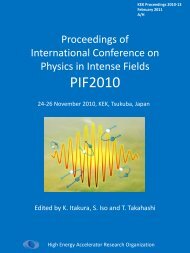TRIAC Progress Report - KEK
TRIAC Progress Report - KEK
TRIAC Progress Report - KEK
You also want an ePaper? Increase the reach of your titles
YUMPU automatically turns print PDFs into web optimized ePapers that Google loves.
In the experiment of RNB-K06 ((Spokesperson: W. Sato (Kanazawa Univ.),<br />
Collaboration: Kanazawa Univ. (1), KURRI (1), <strong>KEK</strong> (4), JAEA (2)), local fields at<br />
111<br />
Cd nuclei in Highly Oriented Pyrolytic Graphite (HOPG) has been investigated by<br />
means of the Time-Differential Perturbed Angular Correlation (TDPAC) method. This<br />
experiment was designed to investigate the physical and chemical states of isolated<br />
atoms introduced in carbon allotropes. For the introduction of the probe 111 Cd nuclei, an<br />
HOPG sheet was irradiated with a very-low energy (30 keV) radioactive nuclear beam<br />
of A = 111 as parents. The observed TDPAC spectra were discussed in terms of lattice<br />
damages produced when introducing the probe into the sample.<br />
As an extension of the present method, the proposal of RNB-KJ02 considers the<br />
possibility to trace the Li macroscopic behavior across the interface in hetero structural<br />
Li ionic conductors in micrometer scale, to be termed 8 Li microscope.<br />
The time spectra shown in Fig. 3-28 represent dynamical movement of Li in the<br />
sample between as-implanted position and surface during a cycle for measurement. For<br />
a single layer (diffusion in homogeneous sample) as discussed in case of Fig.3-26, the<br />
present method can trace, most efficiently, the Li movement within one-dimensional<br />
distance of about 10 µm for about 7 s. For slow diffusion, Li is still moving toward the<br />
surface for the time of measurement, the α-particle yields are monotonically increasing<br />
with time. For moderate diffusivity, a maximum is observed when Li is reflected by the<br />
surface. After the maximum, the yield is simply decreasing with time since Li is<br />
diffusing into the bulk. For double layers (hetero structural sample) whose interface<br />
exist in between, i.e. introducing an interface between the as-implanted position and the<br />
surface, we could observe time structure different from the case of single layer. In other<br />
words, we could observe how Li interacts with the interface, e.g. if Li is precipitated,<br />
perfect or half reflected on the interface. This idea could be applied to take a dynamical<br />
picture of Li in Li ion micro-batteries consisting of thin films of several µm in thickness.<br />
Therefore, the present method could be called 8 Li microscope by analogy with the<br />
neutron transmission image of Li in a secondary Li ion battery, where the picture of Li,<br />
actually 6 Li, in the battery was taken by the neutron radiography with a resolution of<br />
mm [3-46].<br />
For higher sensitivity, from microscale to nanoscale, the proposal of RNB-KJ02<br />
also considers a coincident measurement of two α-particles emitted from position of<br />
β-decaying 8 Li. The micrometer sensitivity of the method discussed so far is partly<br />
coming from the broad energy distribution of α-particles on decaying. Therefore, the<br />
coincident measurement is supposed to dramatically improve the sensitivity since the<br />
87













